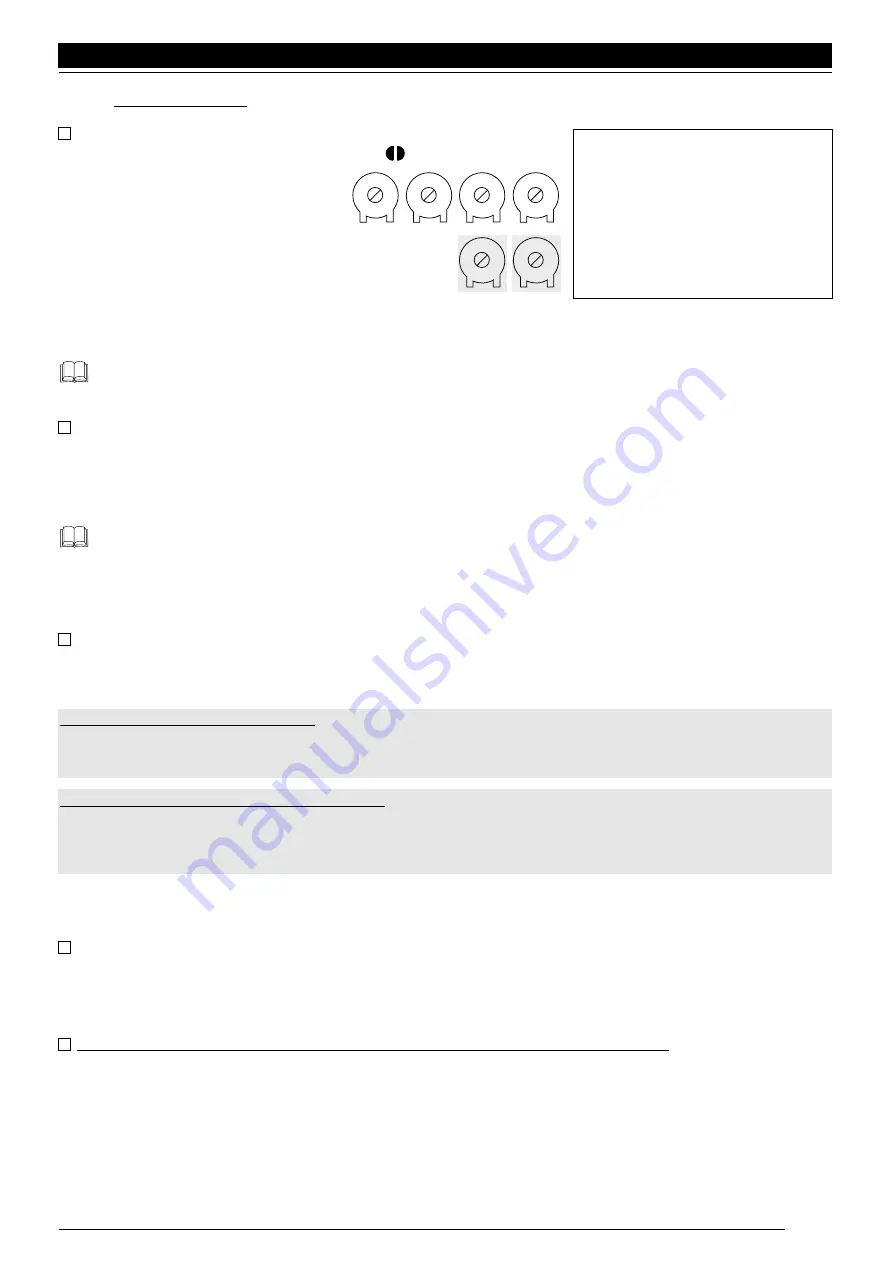
3.1) ADJUSTMENTS:
✓
If the gate has 2 wings that could get bump
into each other if, when opening, they start
simultaneously or, when closing, one moves
on top of the other, you will have to readjust
the Opening Delay Time trimmer “TRA” or the
Closing Delay Time trimmer “TRC”. These
trimmers can be adjusted to your liking,
although as a rule the TRA is set for the time
actually needed and the wing moved by the
2nd motor is already out of the way when the
1st motor starts.
The TRC trimmer must be adjusted so that when closing, the wing moved by the 2nd motor always reaches the end only after the
1st motor has terminated the closing manoeuvre.
The Closing Delay Time can be used as a safety margin of 50 cm in closing as prescribed in point 5.4.2.3 of the UNI
8612 standard, 89th Edition.
✓
Now select the “Semiautomatic” functioning mode by positioning dip-switch no. 1 in ON and adjust the Working Time trimmer
to about halfway of the travel distance. Having made these adjustments, run a complete opening cycle followed by a complete
closing cycle and readjust the Working Time trimmer as needed so that there is enough time for the whole manoeuvre leaving a
margin of about 2 to 3 seconds. If the trimmer is on maximum and there still is not enough time, the TLM jumper on the printed
circuit near the trimmer can be cut to provide more working time.
Point 6.1.5 of the UNI 8612 89th Edition standards states, in order to prevent crushing hazards, among the possible
measurements, that the torque limiting devices used can be adjusted so that maximum gate thrust measured on the corner of the
wing does not exceed 150 N (about 15 kg). In truth, the standard adds the condition that the wing’s kinetic energy must be lower
than 10 Joule (10 N/m) but it is not explicit about the alternative methods to be used; in all cases, it is an excellent solution and
must always be applied!
✓
In some types of actuators, for example the oleodynamic type, force is adjusted directly on the actuator; consult the relative
instruction manual regarding adjustment and leave force adjustment inside the unit on maximum.
For all the types of actuators that do not have a force adjustment device it is possible to exploit the adjustment system of the force
inside the unit: on the basis of the unit version used, follow the relative instructions.
The following refers only to the A6 version
There is a FORCE trimmer on the unit which is usually set for maximum force; with a screwdriver turn the trimmer
counterclockwise to reduce motor force until you reach the value established by the standards.
The following refers only to the A6F e A700F versions
There is an adequately powered autotransformer on the unit with intermediate sockets on the primary winding and which can be
selected by means of a special FORCE commutator; turn the commutator round to the most suitable position to reduce motor force
until you reach the value established by the standards.
Maximum force is provided whatever system is used to adjust the force for the initial movement phase and for a duration of 1.5
seconds; only after this time, defined “Inrush”, is the force established.
✓
If you have chosen the automatic functioning mode (dip-switch No. 2 ON), the end of the opening manoeuvre is followed by a
“pause” time at the end of which a closing manoeuvre follows automatically. The time the gate stays open can be adjusted with
the PAUSE TIME trimmer for the length of time you want, without any limits.
An automatic closing manoeuvre and the relative pause time are activated also in the semiautomatic functioning mode when, in
closing, the triggering of a safety device will cause the gate to reverse direction.
✓
Only now, when all the adjustments have been made, do we advise you to plug in the radio receiver if you have one, reminding
you that the commands it sends are sent to the STEP-BY-STEP input.
English
29
TLM
= Increased Working Time
TL
= Working Time
TP
= Pause Time
TRA
= Opening Delay Time
TRC
= Closing Delay Time
F
= Force
FP
= Positioning Force
TLM
TL
F
FP
TP
TRA
TRC






























